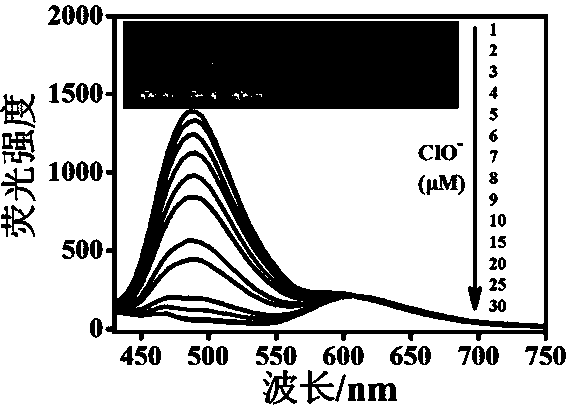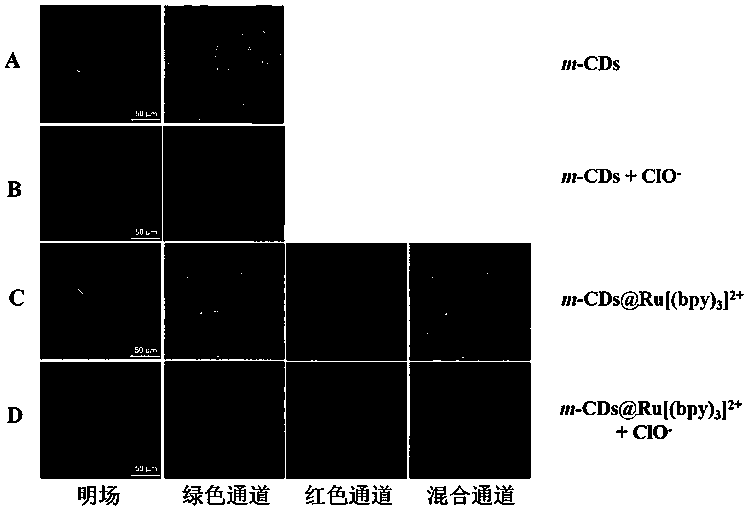Ratio fluorescence nano probe and application thereof
A ratiometric fluorescence, nanoprobe technology, applied in analytical chemistry and nanometer fields, can solve the problem of single color change, and achieve the effect of easy storage, small error and multi-color realization.
- Summary
- Abstract
- Description
- Claims
- Application Information
AI Technical Summary
Problems solved by technology
Method used
Image
Examples
Embodiment 1
[0030] Example 1: m -CDs@[Ru(bpy) 3 ] 2+ Construction of ratiometric fluorescent nanoprobes and their specific responses to ClO -
[0031]Firstly, 0.6 g of m-phenylenediamine was dissolved in 60 mL of absolute ethanol, and then the solution was transferred to a 100 mL polytetrafluoroethylene high-temperature reactor, and the reaction was heated at 180 °C for 12 h, and the reactor was cooled to room temperature. Afterwards, the resulting product was separated and purified by column chromatography (the eluent was dichloromethane:methanol=15:1, v / v), and the obtained solution was spin-dried with a rotary evaporator and then vacuum-dried, that is get carbon dots m - Solid crystallization of CDs. Then adjust to 20 μg / mL at a volume ratio of 6:1 m -Add 40 μg / mL Ru(bpy) to CDs 3 Cl 2 ,be made of m -CDs@[Ru(bpy) 3 ] 2+ Ratiometric fluorescent nanoprobes.
[0032] in income m -CDs@[Ru(bpy) 3 ] 2+ A series of concentrations of ClO were added to the ratiometric fluorescen...
Embodiment 2
[0033] Example 2: m -CDs@[Ru(bpy) 3 ] 2+ Preparation of agarose hydrogel and its specific response to ClO -
[0034] Towards m -CDs@[Ru(bpy) 3 ] 2+ Add agarose powder in, heat and stir m -CDs@[Ru(bpy) 3 ] 2+ The viscous gel of agarose is placed in the groove of the centrifuge tube cover, and it will form a round cake after it cools down. m -CDs@[Ru(bpy) 3 ] 2+ Agarose hydrogel.
[0035] Towards m -CDs@[Ru(bpy) 3 ] 2+ A series of concentrations of ClO were added to the agarose hydrogel - (ClO - The concentrations were 0, 10, 20, 30, 40, 50, 100, 200 μM), and after 5 min of reaction, the fluorescence intensity and color changes were observed under a 365 nm ultraviolet lamp, and a digital camera was used to photograph the fluorescence of the hydrogel imaging (eg figure 2 ).
Embodiment 3
[0036] Example 3: m -CDs@[Ru(bpy) 3 ] 2+ Ratiometric fluorescent nanoprobes for intracellular ClO - Ratio Imaging
[0037] Will m -CDs@[Ru(bpy) 3 ] 2+ Ratiometric fluorescent nanoprobes were added to culture dishes containing HeLa cells, and the 2 / 5%O 2 After culturing in an atmosphere for 1 h, the cells were washed 3-5 times with KRP buffer to remove the cells that did not enter the HeLa cells. m -CDs@[Ru(bpy) 3 ] 2+ , the cells were imaged with a confocal microscope under two fluorescent channels with excitation wavelengths of 488 nm and 543 nm; m -CDs@[Ru(bpy) 3 ] 2+ HeLa cells added 10 μM ClO - , after further incubation for 15 min, the cells were washed 3-5 times with KRP buffer to remove the ClO that did not enter the HeLa cells - , the cells were imaged with a confocal microscope under two channels of excitation wavelength of 488 nm and 543 nm, and observed m -CDs@[Ru(bpy) 3 ] 2+ Ratiometric fluorescent nanoprobes to ClO - responses (such as image 3...
PUM
 Login to View More
Login to View More Abstract
Description
Claims
Application Information
 Login to View More
Login to View More - R&D
- Intellectual Property
- Life Sciences
- Materials
- Tech Scout
- Unparalleled Data Quality
- Higher Quality Content
- 60% Fewer Hallucinations
Browse by: Latest US Patents, China's latest patents, Technical Efficacy Thesaurus, Application Domain, Technology Topic, Popular Technical Reports.
© 2025 PatSnap. All rights reserved.Legal|Privacy policy|Modern Slavery Act Transparency Statement|Sitemap|About US| Contact US: help@patsnap.com



